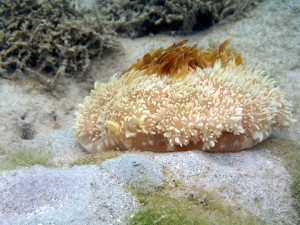Upside-Down Jellyfish
Upside-Down Jellyfish (Cassiopea andromeda)

Photo Courtesy of DAR
Description:
- Yellow with white and pale spots (EOR, 2015)
- Brown frilly tentacles (EOR, 2015)
- Can grow up to 30 centimeters in diameter (Bishop Museum, 2001)
- Often mistaken for sea anemones (Eldredge & Smith, 2001)
Habitat:
- Lies upside down on sandy bottoms (EOR, 2015)
- Found in calm, shallow water such as lagoons and intertidal flats (EOR, 2015)
Impacts & Concern:
- Have a mild sting (Eldredge and Smith, 2001)
- Ecological impacts have not been studied (Eldredge & Smith, 2001)
Introduction:
- Came from the Philippines to Pearl Harbor between 1941 and 1945 (Eldredge & Smith, 2001)
- Spread by hull fouling or in the ballast water of ships (EOR, 2015)
Distribution in Hawaii:
- Kauai: Not documented
- O‘ahu: Kāne‘ohe Bay, Ala Wai Canal, Honolulu Harbor (Eldredge & Smith, 2001)
- Molokai: Kaunakakai (Eldredge & Smith, 2001)
- Lanai: Not documented
- Maui: Not documented
- Big Island: Waikoloa fish ponds (Eldredge & Smith, 2001)
References:
- Eldredge, L. G., & Smith, C. M. (2001). A guidebook of introduced marine species in Hawaii. Honolulu: Bishop Museum and the Univ. of Hawai’i
- Eyes of the Reef (EOR). (2015). Alien invasive invertebrates- Upside down jellyfish. Eyes of the Reef Hawaiʻi. https://eorhawaii.org/education/marine-invasive-species/invertebrates/
- Bishop Museum. (2001). Cassiopea andromeda. Introduced marine species of Hawaii Guidebook. https://www2.bishopmuseum.org/HBS/invertguide/species/cassiopea_andromeda.htm